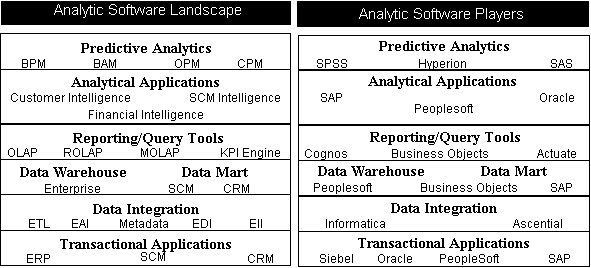|
|
| Home - Industry Article - Aug 03 Issue |
The Next Generation of Analytic Software |
By Anita P. Rao, Vice President, Garage Technology Ventures
Introduction
Rapidly changing business conditions are driving the demand for a new generation of analytic software, making it an area ripe for innovation and investment. Now, more than ever, managers of both large and small corporations require real-time visibility into business operations and the ability to react immediately to a dynamic business environment, or they risk paying a penaltyŚlike writing off inventory, or losing orders due to stock outs. In addition, new corporate governance requirements have increased the pressure on executives to build transparency into all aspects of their business activities. Thus, the growing need for a new breed of analytic software to help achieve the Intelligent Enterprise.
Historical Perspective
Businesses today generate an immense amount of data from the increasingly sophisticated transactional systems spanning Enterprise Resource Planning (ERP), Supply Chain Management (SCM), and Customer Relationship Management (CRM). In the past, to extract information from this data, IT departments had to create some type of basic analytics framework, including custom and ad-hoc reports, which may have had some additional drill-down capabilities. While basic metrics in the form of key performance indicators (KPIs) were also created and were used to generate alerts, these typically were limited to data from within one application or occasionally across a specified set of applications when a data warehouse or data mart was used. However, since such notifications were generated well after the triggering event occurred, the information was less valuable. The information that businesses have been able to obtain from such systems has been retrospective, without providing much advice or prediction capabilities, much less been able to trigger corrective actions for risk mitigation.
Trends influencing the direction of Business Intelligence (BI)
The trend toward ever expanding volumes of operating data will continue as enterprises adopt new technologies such as AutoID in the supply and demand chains. The enormous amount of data created has intensified the challenge for users to extract knowledge for effective business decisions.
The current competitive environment has also forced enterprises to streamline business processes to increase operational efficiencies. Customers today demand a personalized product at a lower cost delivered in a shorter time span. In order to meet these demands, enterprises need accurate information in near real-time to make quick business decisions.
A typical enterprise today works collaboratively with its partners and suppliers. Across the extended enterprise, decisions are made jointly among a distributed group of people. Within an enterprise as well, strategy and goals are set by a group of people that together implement, monitor and react to changes. This has created an opportunity for collaborative applications within analytic software.
Key macro events, such as recent terrorist threats, have fueled the demand for predictive analytics capability. The attacks of September 11 have increased the demand for systems capable of analyzing petabytes of government intelligence data to identify terrorist threats.
Consolidation throughout industry has resulted in companies that have multiple ERP systems. Transitioning from these heterogeneous ERP environments to one master system is an arduous and time-consuming process. In the interim, these enterprises continue to employ sophisticated data integration tools, often supplemented with massive manual efforts, to close their books at the end of the quarter.
The BI Landscape and Players
The figures below provide a high level summary of the analytic software landscape and the key players in each segment.

At the ground level the transactional applications are those that are used to run the operational side of the business. These include ERP, CRM, and SCM systems and are provided by vendors such as SAP or Siebel.
The next level in the stack is the Data Integration layer. This layer includes a metadata repository for storing the enterprise data model with data definitions. The players here include Informatica and Ascential. Enterprise Information Integration (EII) is another emerging area that includes players like Metamatrix and Nimble Technologies. Here, the solution defines an enterprise data model and integrates structured and unstructured data to provide a view of enterprise-wide data. This layer also includes EAI (Enterprise Application Integration) and EDI (Electronic Data Interchange).
The stores for data include data marts or a data warehouse. Transactional application vendors like SAP, PeopleSoft and Oracle provide a warehouse with schemas that map to their applications. They also deliver out of the box analytics with reports and some KPIs that make implementation faster and cheaper.
Tools for extracting data from data stores include reporting engines. These are used to provide pre-built reports for functional areas and also allow the users to create and schedule ad-hoc reports. Some vendors that provide this include Business Objects, Microstrategy, Actuate, Crystal Decisions and Cognos.
The vendors of the OLTP transactional systems typically provide analytic applications as well. Recently, Informatica and Business Objects have also moved into the application space. Applications typically include reports and KPIs, for certain functional areas and are also customized for specific vertical industries.
|
|


|

